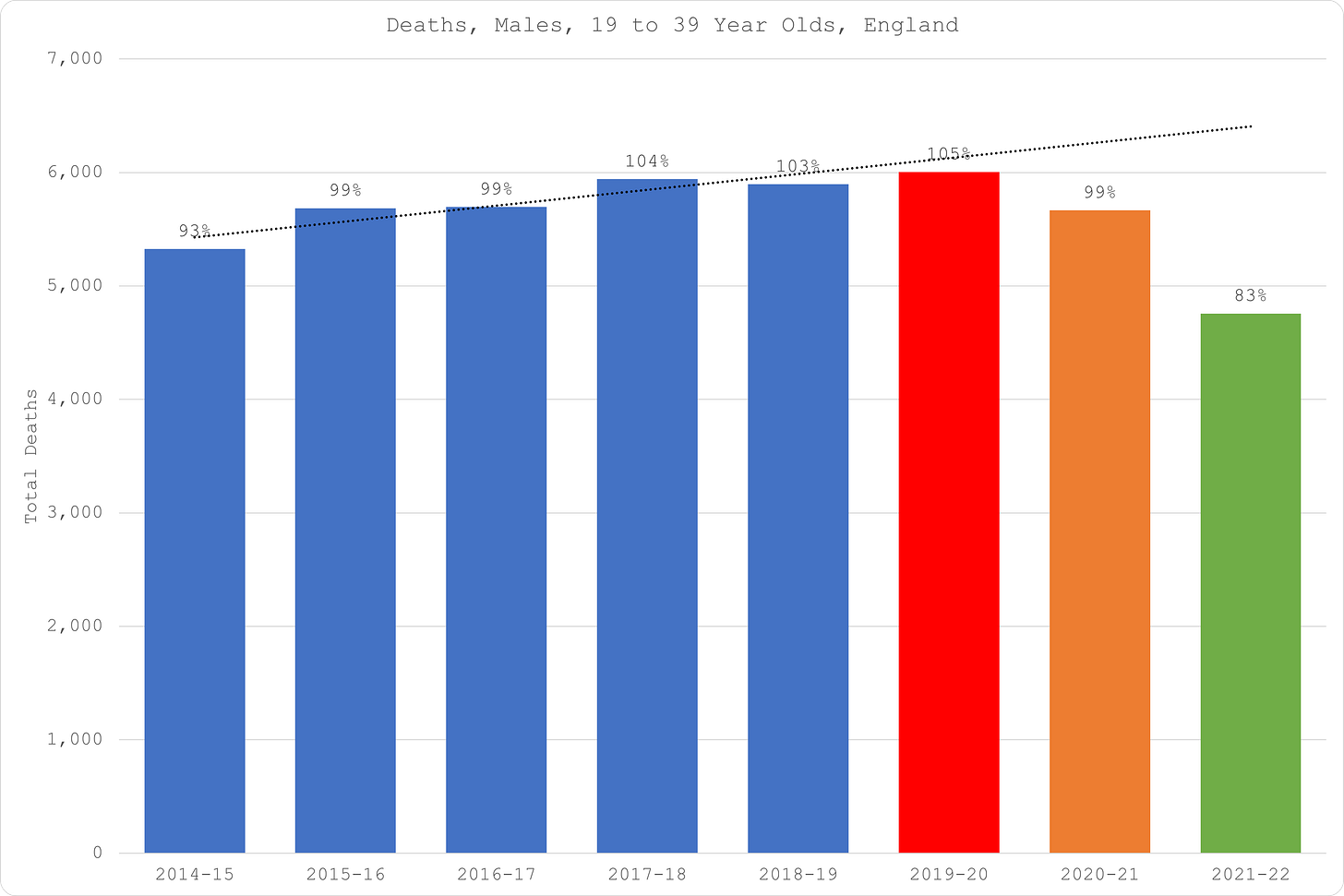Did the COVID-19 "Vaccine" Protect Healthcare Workers from Death?
Analysis of excess mortality of 19 to 39 year olds males vs females might suggest that the "vaccine" actually increased deaths.
For the entire mortality year (July to June), COVID does not seem to have had any impact on expected deaths of 19 to 39 year old males in England. 105% of the average from 2014 to 2019 is the highest “excess” of the observation period but below the upward trend (Figure 1)1.
In other words, when taking the trend into consideration, we would expect 2019-20 total deaths to be higher than they actually were in spite of the pandemic.
Conversely, it is still possible to isolate specific periods of unexpected deaths within a mortality year (Figure 2). As it happens, young English males start dying “unexpectedly” on 20-Feb-20, a whole month before COVID deaths were registered for this age group.
And when they are registered, the excess death curve does not deviate - “in spite” of the measures designed to mitigate the spread and reduce deaths - until coming to a natural end on 01-May-20. I say natural because there is nothing unnatural that coincides with the end of this mortality run.
In all, the “epidemic” COVID period (and the month before) racked up 190 excess or unexpected deaths, representing 3% of usual total deaths in a mortality year for this cohort (marked “A” on the chart). Incidentally, the official COVID death count for this cohort period is 179 for both sexes.
Curiously, even though COVID makes its seasonal return in mid-Sept 2020, and the official death toll for this age cohort (both sexes) is 146 up to 27-Dec-20, in terms of excess deaths, there is actually a deficit of 88. This is possibly due to the pull forward effect of the deaths that occurred in the spring.
However, whatever explanation we might conjure up for the disparity between COVID deaths and excess deaths, it is very clear that a mortality event is triggered on 27-Dec-20, lasting until 28-Feb-21 and racking up 159 unexpected deaths, again 3% of the usual total for a mortality year (marked “B” on the chart).
Curiosity getting the better of me (and my love of Occam’s razor to simplify things), I’d have to look at the mRNA experiment as that potential trigger. Whether it’s a new, deadly variant or a new susceptible pool, both can be explained by the gene therapy and there is nothing else that happened at that time.
But perhaps, most weird of all, is the period between 15-Jul-21 and 18-Aug-21, the heart of summer, which registers 105 unexpected deaths (marked “C” on the chart).
Finally, it looks like another “wave” of unexpected deaths befalls this cohort, emerging on 07-Dec-21. Unfortunately, because so many deaths have been reported to the coroner, that’s as far as we can reasonably and reliably go because the data is simply too incomplete after this point.
But let’s return to the vaccine hypothesis. Here’s a chart showing the rate at which this cohort lined up for the experiment:
To make things easier, I’ve marked the start of each campaign.
Oh look, each and every single death wave coincides within days of a new vaccination drive. Makes you wonder, doesn’t it? Or shall we just file that under “correlation does not equal causation” and get back to the BBC news?
The first drive is for the healthcare workers. This is important because I’m going to refer back to this later.
Now let’s turn our attention to the females, who typically die half as often as the males in this age cohort so I’ve shown them on the same scale to make it obvious:
Blatant copy/paste/edit from the males…
For the entire mortality year (July to June), COVID does not seem to have had any impact on expected deaths of 19 to 39 year old females in England. 104% of the average from 2014 to 2019 is the highest “excess” of the observation period but below the upward trend (Figure 4).
In other words, when taking the trend into consideration, we would expect 2019-20 total deaths to be higher than they actually were in spite of the pandemic.
More copy/paste/edit…
Conversely, it is still possible to isolate specific periods of unexpected deaths within a mortality year (Figure 5). As it happens, young English females start dying “unexpectedly” on 12-Feb-20, a week before the males and a whole month before COVID deaths were registered for this age group.
And when they are registered, the excess death curve does not deviate - “in spite” of the measures designed to mitigate the spread and reduce deaths - until coming to a natural end on 02-May-20. I say natural because there is nothing unnatural that coincides with the end of this mortality run.
In all, the “epidemic” COVID period (and the month before) racked up 168 excess or unexpected deaths, representing 6% of usual total deaths in a mortality year for this cohort (marked “A” on the chart). That’s twice as many as the males.
Curiously, even though COVID makes its seasonal return in mid-Sept 2020, and the official death toll for this age cohort is 151 (both sexes) up to 28-Dec-20, in terms of excess deaths, there is a surplus of 106. No pull forward effect of the deaths that occurred in the spring is apparent here then?
However, whatever explanation we might conjure up for the disparity between COVID deaths and excess deaths, it is very clear that a mortality event is triggered on 27-Dec-20, lasting until 21-Feb-21 and racking up 280 unexpected deaths, this time 9% of the usual total for a mortality year (marked “B” on the chart). that’s three times as much excess death as the males. We will come back to this.
Unlike the males, there is no mortality event for the females during the period between 15-Jul-21 and 18-Aug-21, the heart of summer. Instead, there is a smaller wave of death between 24-Aug-21 and 12-Sept-21, still very distinct (marked “C” on the chart).
So, what happens if we put this altogether under the rule of Occam’s razor?
It would have been great if the vaccination data was stratified by sex as well as age but I’m going to speculate that there are more female healthcare workers getting jabbed in the first bout of the experiment than males. If that’s the case, could that explain why there are three times as many excess deaths during that same period for the females compared to the males, whereas there was only twice as many during “natural” COVID the prior spring?
There’s still a lot of unanswered questions for me with the data that’s available. Possibly, we might get some better insight when the ONS finally add location and cause of death to this proprietary dataset.
Until then, what do you think, on the basis of the evidence that we have?
The data for 2021-22 is incomplete so nothing should be read into what appears to be a massive deficit.










“Oh look, each and every single death wave coincides within days of a new vaccination drive.” <- This right here says it all. Fantastic work, as usual. You are greatly appreciated!
👍
Vaccination drove the disease... It's evident. France, summer 21 after the pre holiday drive had me convinced. Get your spike and go on hols...